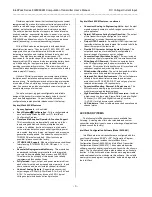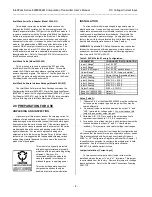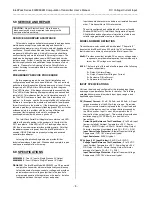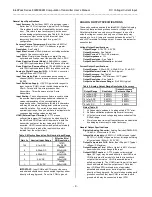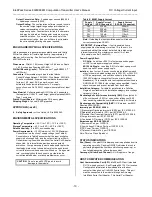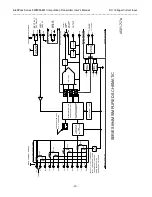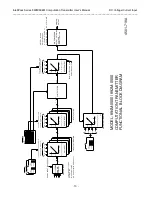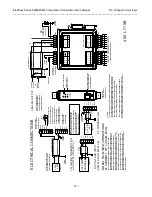
IntelliPack Series 892M/894M Computation Transmitter User's Manual DC Voltage/Current Input
___________________________________________________________________________________________
- 8 -
5.0 SERVICE AND REPAIR
CAUTION:
Risk of Electric Shock - More than one
disconnect switch may be required to de-energize the
equipment before servicing.
SERVICE AND REPAIR ASSISTANCE
This module contains solid-state components and requires no
maintenance, except for periodic cleaning and transmitter
configuration parameter (zero, full-scale, setpoint, deadband, etc)
verification. Since Surface Mounted Technology (SMT) boards
are generally difficult to repair, it is highly recommended that a
non-functioning module be returned to Acromag for repair. The
board can be damaged unless special SMT repair and service
tools are used. Further, Acromag has automated test equipment
that thoroughly checks and calibrates the performance of each
module. Please refer to Acromag’s Service Policy Bulletin or
contact Acromag for complete details on how to obtain service
parts and repair.
PRELIMINARY SERVICE PROCEDURE
Before beginning repair, be sure that all installation and
configuration procedures have been followed. The unit routinely
performs internal diagnostics following power-up or reset. During
this period, all LED’s will turn ON momentarily, and the green
“Run” LED flashes. If the diagnostics complete successfully, the
“Run” LED will stop flashing after approximately one second and
remain ON. This indicates that the unit is operating normally. If
the “Run” LED continues to flash, then this is indicative of a
problem. In this case, use the Acromag IntelliPack Configuration
Software to reconfigure the module or download its firmware and
this will usually cure the problem. If the diagnostics continue to
indicate a problem (a continuously flashing green LED), or if other
evidence points to a problem with the unit, an effective and
convenient fault diagnosis method is to exchange the
questionable module with a known good unit.
The IntelliPack Serial Port Adapter also contains a red LED
visible at the small opening in the enclosure to the right of the
RJ11 receptacle. If this LED is OFF or Flashing and power is
ON, then a communication interface problem exists. Note that
the adapter receives its power from the IntelliPack module. A
constant ON LED indicates a properly working and powered
serial interface adapter.
Acromag’s Application Engineers can provide further
technical assistance if required. When needed, complete repair
services are available from Acromag.
6.0 SPECIFICATIONS
892M-0500-C
, Two I/V Inputs, Single Process I/V Output
894M-0500-C
, Four I/V Inputs, Single Process I/V Output
General:
The IntelliPack Model 89XM-0500 is a DC-powered
computation transmitter which mathematically combines up
to four channels of process current or voltage, and provides
an isolated current or voltage output that is the result of a
programmed equation that operates on the inputs. Isolation
is supplied between the input, output, and power.
Input channels share common and are not isolated from each
other. This transmitter is DIN-rail mounted.
The unit is configured and calibrated with our user-friendly
Window 95/98
or NT
IntelliPack Configuration Program.
All calibration and configuration information is stored in non-
volatile reprogrammable memory in the module.
MODEL NUMBER DEFINITION
Transmitters are color coded with a white label. The prefix “8”
denotes the IntelliPack Series 800, while the “M” suffix specifies
that this device is primarily a computation (Math) transmitter.
89xM:
Provides a resultant isolated DC current or voltage output
response to a mathematical equation that combines up to
two or four DC voltage or current inputs.
-0500:
The four digits of this model suffix represent the following
options, respectively:
0 = Relay: No Alarm Relay;
5 = Output: Transmitter Voltage or Current;
0 = Enclosure: DIN rail mount;
0 = Approvals: cULus Listed.
INPUT SPECIFICATIONS
Unit must be wired and configured for the intended input types
and ranges (see Installation Section for details). The following
paragraphs summarize this model’s input types, ranges, and
applicable specifications.
DC (Process) Current:
0-1mA, 0-20mA, and 4-20mA. All input
ranges are subsets of the 0-20mA input range. A precision
49.9
current sink resistor is placed in the I+ input lead and
converts the input current to a voltage that is processed by
the A/D converter. Input I+ must be jumpered to the V+
terminal to utilize current input. This module also provides an
excitation supply (15VDC/48mA) for use with 2-wire
transmitters.
Current Input Reference Test Conditions:
4 to 20mA input
(jumper installed); Ambient Temperature = 25
C; Power
Supply = 24VDC; Output = 4-20mA, Normal Acting; Output
Formula = average of combined inputs [(A + B + C + D)/4].
Input Overvoltage Protection:
Bipolar Transient Voltage
Suppressers (TVS), 18V clamp level typical.
Input Resistance:
550K
, typical.
DC Voltage (10:1 Input Divider):
0-5VDC or 0-10VDC.
Voltage Input Reference Test Conditions:
0 to 10V DC
input; Ambient Temperature = 25
C; Power Supply = 24V
DC; Output = 4-20mA, Normal Acting; Output Formula =
average of all inputs [(A + B + C + D)/4].
Input Overvoltage Protection:
Bipolar Transient Voltage
Suppressers (TVS), 18V clamp level typical.



